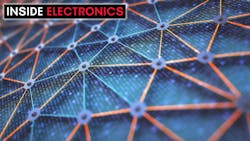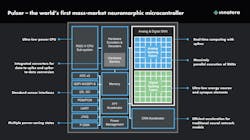For Ultra-Low-Power Neural Networks, Try Spiking Neural Networks
What you'll learn:
- What’s the difference between analog and digital spiking neural networks (SNNs)?
- Why analog and digital SNNs are complementary.
- Details about Innatera’s Pulsar SSN-based microcontroller.
Spiking neural networks (SNNs), also known as neuromorphic computing, are one way to implement artificial-intelligence/machine-learning (AI/ML) models. They have significant advantages over the more popular digital deep neural networks (DNNs) like convolutional neural networks (CNNs), one of them being very low power operation.
I spoke with Innatera’s CEO, Sumeet Kumar, about how the company’s new, ultra-low-power microcontroller can provide always-on (AON) SNN support in battery power- or energy harvesting-based applications (listen to the podcast).
Innatera’s Pulsar system-on-chip (SoC) integrates multiple, low-power accelerators that target sensor-based solutions (see figure). It provides better system latency, privacy, and performance compared to cloud-based AI/ML support and more power-hungry, non-SNN, edge-based solutions.
The Pulsar actually includes an analog and a digital SNN accelerator. Each has advantages and disadvantages. The analog implementation is even more power-efficient while the digital version provides greater programming flexibility.
SHOW NOTES
01:01 – MCU Evolution
03:26 – Spiking Neural Networks
07:13 – Pulsar's Architecture
09:31 – Onboard Accelerators
14:20 – RISC-V Core
15:46 – Software Tools & Security
18:18 – Pulsar Applications
About the Author
William G. Wong
Senior Content Director - Electronic Design and Microwaves & RF
I am Editor of Electronic Design focusing on embedded, software, and systems. As Senior Content Director, I also manage Microwaves & RF and I work with a great team of editors to provide engineers, programmers, developers and technical managers with interesting and useful articles and videos on a regular basis. Check out our free newsletters to see the latest content.
You can send press releases for new products for possible coverage on the website. I am also interested in receiving contributed articles for publishing on our website. Use our template and send to me along with a signed release form.
Check out my blog, AltEmbedded on Electronic Design, as well as his latest articles on this site that are listed below.
You can visit my social media via these links:
- AltEmbedded on Electronic Design
- Bill Wong on Facebook
- @AltEmbedded on Twitter
- Bill Wong on LinkedIn
I earned a Bachelor of Electrical Engineering at the Georgia Institute of Technology and a Masters in Computer Science from Rutgers University. I still do a bit of programming using everything from C and C++ to Rust and Ada/SPARK. I do a bit of PHP programming for Drupal websites. I have posted a few Drupal modules.
I still get a hand on software and electronic hardware. Some of this can be found on our Kit Close-Up video series. You can also see me on many of our TechXchange Talk videos. I am interested in a range of projects from robotics to artificial intelligence.
Sumeet Kumar
Co-Founder and CEO, Innatera Nanosystems
Sumeet Kumar is Co-Founder and CEO of Innatera Nanosystems, a semiconductor startup that aims to simplify sensor data analytics in power constrained devices.


